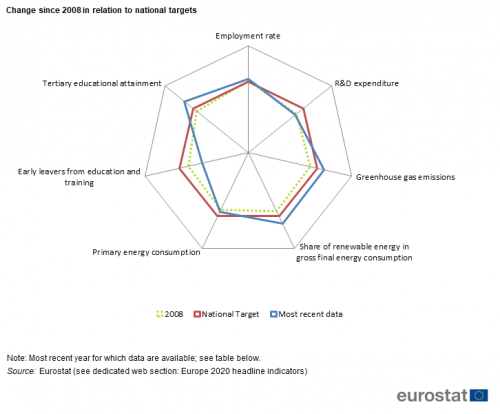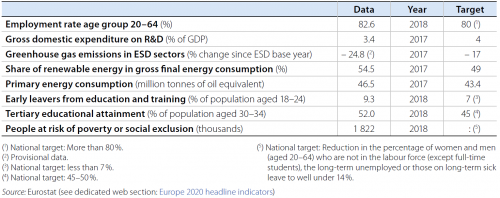Archive:Europe 2020 indicators - Sweden
Data extracted in June 2019. Planned article update: September 2020.

Source: Eurostat (see dedicated web section: Europe 2020 headline indicators)
Explanations on this radar chart are available here.
This article is part of a set of statistical articles on Europe 2020 strategy, focusing on the situation in Sweden.
Full article
Overview
With 52.0 % of its population aged 30 to 34 years having attained a tertiary education in 2018, Sweden exceeded its national 2020 target by 7.0 percentage points. In contrast, the share of early school leavers from education and training in 2018 was 2.3 percentage points above the national target in 2018. In the same year, the country exceeded its employment target by 2.6 percentage points and had the highest employment rates in the EU. In 2017, Sweden also surpassed its renewable energy target by increasing the share of renewables in gross final energy consumption to 54.5 % — by far the best performance in the EU. By reducing its GHG emissions by 24.8 % until 2017 (compared with the ESD base year), Sweden met its respective national target. However, the country was still 3.1 Mtoe above its primary energy consumption target by 2017. Despite having the highest R&D intensity across the EU, the country has to close a 0.6 percentage point gap between 2017 and 2020 to meet its ambitious national target of spending 4 % of GDP on R&D.

Source: Eurostat (see dedicated web section: Europe 2020 headline indicators)
Data sources
More information about the origin of the data and the calculation of indicators can be obtained via the Europe 2020 indicators dedicated website.
Under 'Main tables', click on the icons next to the indicators:
- 'Explanatory texts (metadata)' for a detailed overview of the collection and compilation methods;
- 'Information on the leaf' for data availability per country.
A more general overview of quality procedures can be found in Implementation of standard reference metadata for indicators - the ESMS Indicator Profile (ESMS-IP) (PDF file).
Context
Europe 2020 is the EU’s agenda for jobs and growth for the current decade. It emphasises smart, sustainable and inclusive growth as a way to strengthen the EU economy and prepare its structure for the challenges of the next decade. As a main objective, the strategy strives to deliver high levels of employment, productivity and social cohesion in the Member States, while reducing the impact on the natural environment.
Direct access to
- Smarter, greener, more inclusive - indicators to support the Europe 2020 strategy - 2019 edition (online publication, also downloadable as PDF file
- Towards robust quality management for European Statistics - Communication from the Commission to the European Parliament and the Council COM(2011) 211 final.
- Regulation (EC) No 223/2009 of 11 March 2009 on European statistics